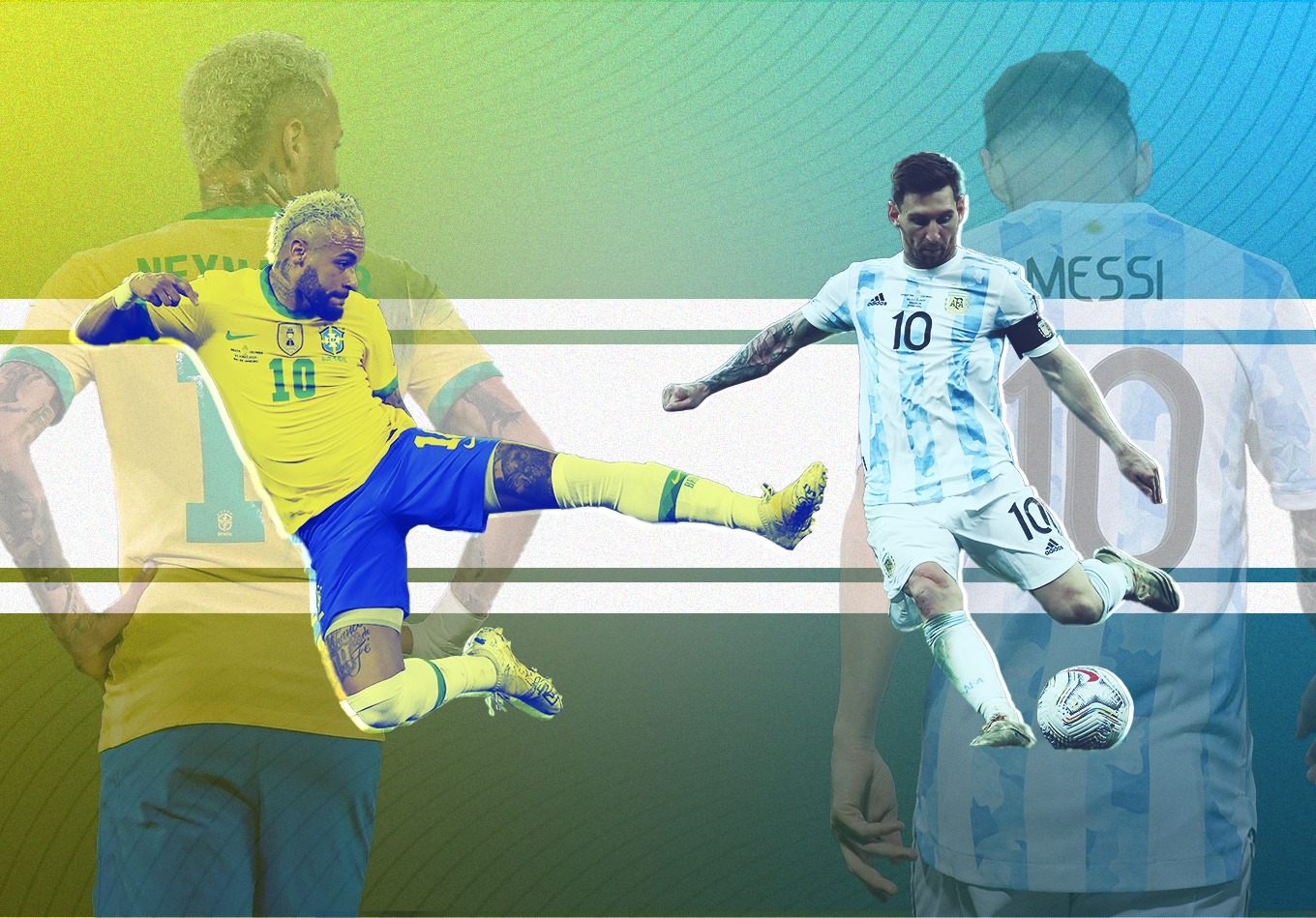Or should it be The Copa América Final of Copa América Finals? Or Messi vs. Neymar? Who cares… It’s a little bit of all of that and more, including an elite Argentine goalkeeper for a change. One with a lot to say, and one who may have a lot to save too.
It was easy to talk about Argentina when CONMEBOL’s World Cup qualification began. It was easy because we had practiced the phrases since 2018 to the point of perhaps knowing them in various languages: “No ideas going forward” and “too reliant on that number 10” and “surely that’s Javier Mascherano’s kid wearing 14” as if it was more on him than his country to produce a midfielder to replace him.
But what we talked about when we talked about Argentina in 2019 should no longer be what we talk about when we talk about Argentina in 2021. Lionel Messi and a capable supporting cast have a chance to put that conversation to bed on South America’s biggest stage against the only suitable opponent to make the story the story it needs to be. It’s Argentina-Brazil in a major tournament final for the first time since Brazil won 3-0 in the 2007 final. It will happen on Saturday night, and Messi will or won’t win his first major title for his country – a country that has lost its last five major tournament finals since winning Copa América 1993.
That’s compelling. It’s even more compelling because, for everything Argentina may be becoming, it may matter little because of who Brazil seem to already be. It’s unsurprisingly in vogue at the moment for football experts and fans alike to affirmatively state whether Brazil could win Euro 2020. Some dismiss Brazil’s unbeaten streak because it has come against what they deem to be a presently weaker-than-normal South American field, and some praise it for coming against a South American field because they believe South American football is the least diluted on the planet.
These are interesting conversations, but these are also, in non-World Cup years, conversations akin to which being you adamantly believe would win in a fight: a bear and a shark in some water-open air hybrid of an octagon.
What’s less impossible to know: Brazil more than occasionally win World Cups, and Brazil haven’t lost a competitive match since Jude Bellingham was days removed from 14 and Corona was still nearly two years away from being more than a refreshing final destination for a lime. The other reality is, no matter which tournament you prefer, there are massively compelling storylines. At the Euros, the redemption of Italy and England sees them face off in a final for the ages, and the ultras. For the Copa, a continent’s legendary duo boasting unmatched individual talents will do just fine.
The surface-level styles of these two teams compared to the Copa América field are not surprising. They both play intricately – though we’ll come back to this with how it’s changed for Argentina – and neither force it over the top:
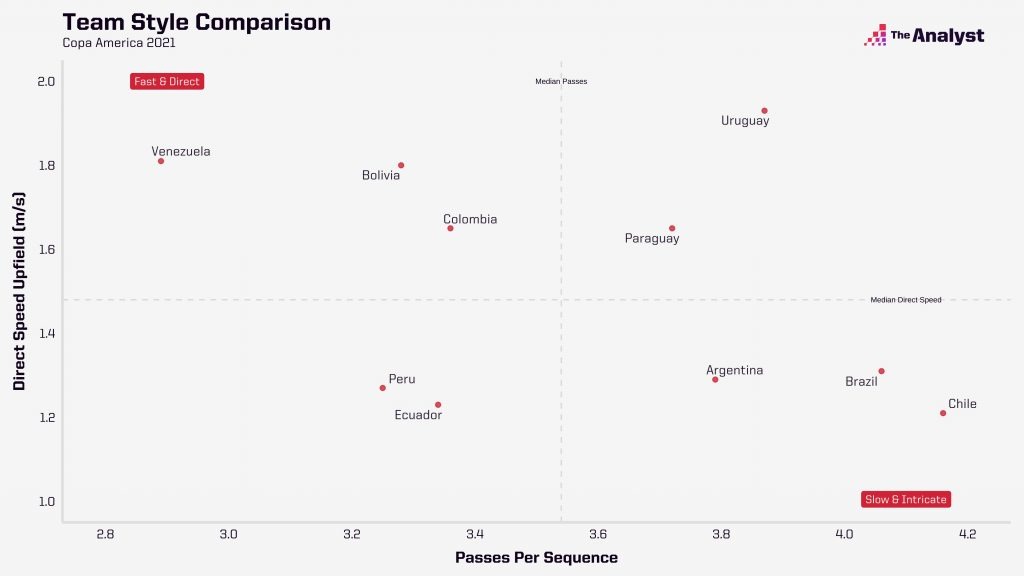
The hosts and favourites Brazil are moving the ball a bit more in their build up (4.06 passes per sequence vs. Argentina’s 3.79), but both sides are playing with the same direct speed. It’s a style that has suited Brazil under Tite. Since losing to Belgium at the 2018 World Cup, they’ve gone unbeaten in 18 competitive matches (W15, D3) while scoring 41 goals and conceding just five.
At this tournament and in World Cup qualification, Brazil have won 1-0 with 10 men and they have won 4-0 when it seemed like it wouldn’t have mattered if they had had only nine. Their total of 12 goals in this tournament sees reasonable until you’re directed to their 17.3 xG, so if anything their scoring has been far more conservative and underwhelming given the variety of chances they’ve had.
They have in the last three years frequently been dominant to the point of it hardly mattering if they take their chances with efficiency. Give a striker that kind of pressure-relieving information – that it’s not absolutely imperative that they score – and they’re probably going to be calm enough to score.
There’s more to talk about at a team level with Argentina because Lionel Scaloni’s team have changed more – perhaps out of an obvious necessity to those who had watched them in recent tournaments, but also because they appear to be a more dynamic (and perhaps better) team.
At the 2018 World Cup, they prodded. They were easy to defend. They struggled to break lines and settled for that goal Ángel Di María scored in your backyard to scare France for a few minutes. They were only repeatable if Di María was in fact alone in your garden rather than in front of Paul Pogba. In numbers, that showed with massive possession figures but only a non-penalty xG of an expected goal per game.
| Competition | Poss% | Direct speed (m/s) | Passes/seq. | Sequence time (sec.) | Avg. start (metres from goal) | Non-penalty xG | Non-penalty goals |
|---|---|---|---|---|---|---|---|
| 2018 World Cup | 65.9 | 1.17 | 4.29 | 11.8 | 45 | 1.01 | 1.5 |
| 2019 Copa América | 48.9 | 1.64 | 3.33 | 9.3 | 42 | 1.58 | 1 |
| 2022 WC qualifiers | 54.3 | 1.23 | 3.69 | 10 | 41.7 | 1.12 | 1.17 |
| 2021 Copa América | 51.3 | 1.29 | 3.79 | 10.8 | 43.4 | 2.33 | 1.67 |
Note that they’ve more than doubled that non-pen xG at the current Copa. With the improvement came a dip in possession, which at the current tournament ranks sixth of 10 teams. The 2019 Copa was a low and a direct style that’s hard to relate to any Argentina side. What they seem to be reaching is a balance. Possession at a short tournament can be heavily influenced by game state (time spent with a lead or trailing), but regardless, the chances and the scoring are up. And it hasn’t meant a rash of quality chances to defend, which is promising given the uncertainly this backline can’t shake. Their 0.71 xG against (including the penalty conceded and invariably saved by Emiliano Martínez) is third to Brazil and Uruguay.
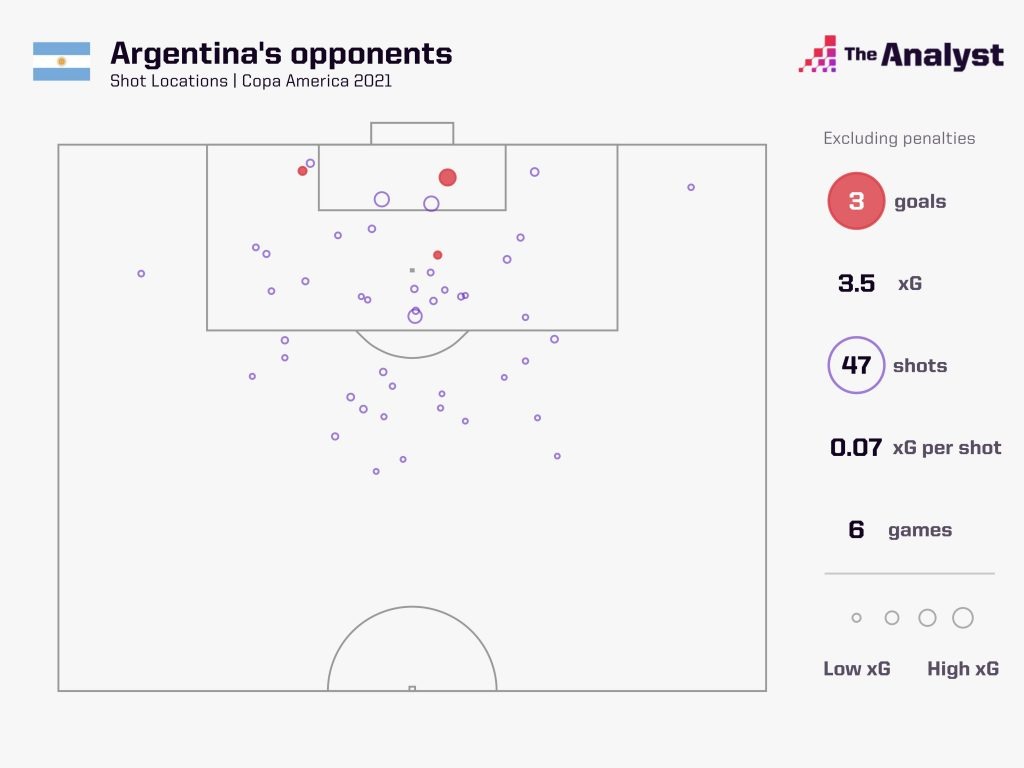
Numbers, though, aren’t everything, and the number of people who truly trust this back four may be four plus immediate family. On top of that, defending against Brazil is different than defending against Chile, Uruguay, Paraguay, Bolivia, Ecuador and Colombia. That 3.5 non-penalty xG against you see above spread over six matches against Argentina is a figure Brazil have put up in single matches with some regularity during their unbeaten streak.
And in that case it helps for an opponent to have a goalkeeper on the up and up. Emiliano Martínez, Lionel Messi says, has been a “phenomenon.” Pick your percentage on penalties: Say, 55% mental, 45% skill. Whatever you pick, increase the mental aspect of it when facing Martínez. He will tell you lines you expect to hear in a therapy session when you’re standing 12 yards from him at the penalty spot: “You’re laughing because you’re nervous.” And – OK – maybe you’ve gone budget if your therapist is saying “I’m going to eat you alive, brother. I’m sorry, but I will.”
Marry that with some clear talent, and you’ve got a keeper who is going to save you some goals. We normally, correctly, wouldn’t put penalty shootout goals in a graphic such as this because perhaps you’ve heard they aren’t actual goals, but a loud mouth must be met with a loud graphic:
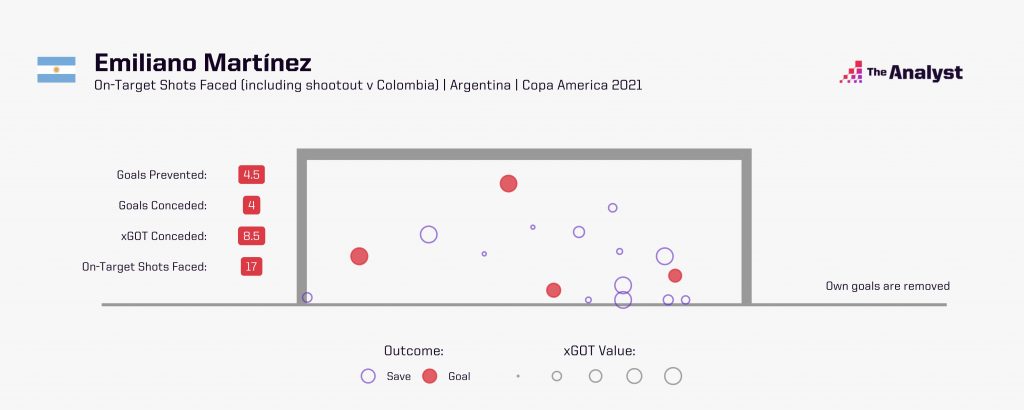
If you’re looking for something excluding shootouts, know that in the Premier League last season Aston Villa benefited by Martinez preventing 4.7 of 49.7 expected goals on target conceded.
What’s just happened is we’ve discussed goalkeeping before the play of Neymar and Messi, which can be argued to be a bad strategy for keeping a reader on a page. So let’s do that before we lose you. Martínez is at some point going to have to either yell at Neymar or stop one of his shots or both fractions of a second apart. Yeah, The CONMEBOL Theatre that is Maracanã is limited to 5,500 fans, but the show will go on.
At risk of giving Martínez something more to yell about, here we go. Brazil won the last Copa América, but they did it without Neymar. At least in English-language Copa América broadcasts, there’s been plenty of talk about a reputation makeover Neymar is after. The high-level data discussion is the same as it’s been in big matches for Paris Saint-Germain: A fabulously skilled player who’s unable to finish his share. His 5.93 xG leads the tournament. At a per-90 rate of 1.19, it’s well above next-best Lautaro Martínez (0.88). It has ended in two total goals, so personal and sporting reputations aside, he’s not doing his finishing reputation any good.
We can’t leave it at that. Neymar can be argued to be as influential of a player as there is at any tournament taking place this summer. His 39 shot-ending involvements from open play lead the tournament (in five games to a certain other’s six), and his chances created from open play are joint-most with that other guy you’ve 100% heard of:
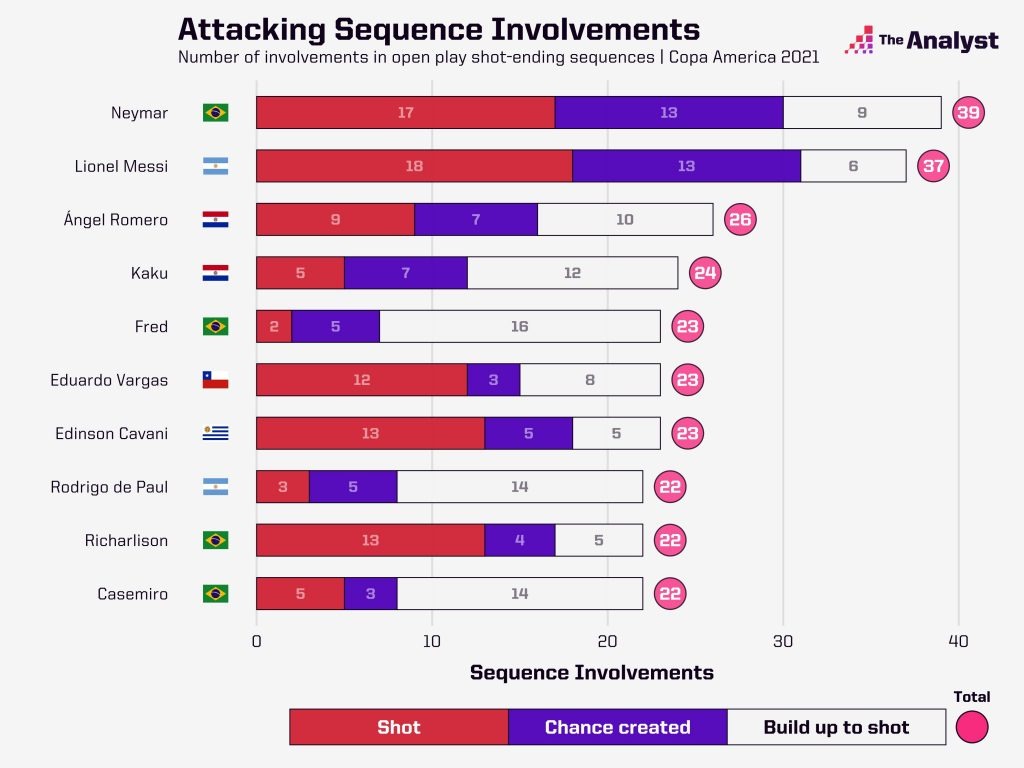
This happens by being involved in consequential possession, which he does with various teammates. A progressive pass is one completed having traveled a minimum of 10 metres upfield. Neymar has combined to be involved in 162 of Brazil’s 865 (18.7%) among the 11 players making up top 10 combinations:
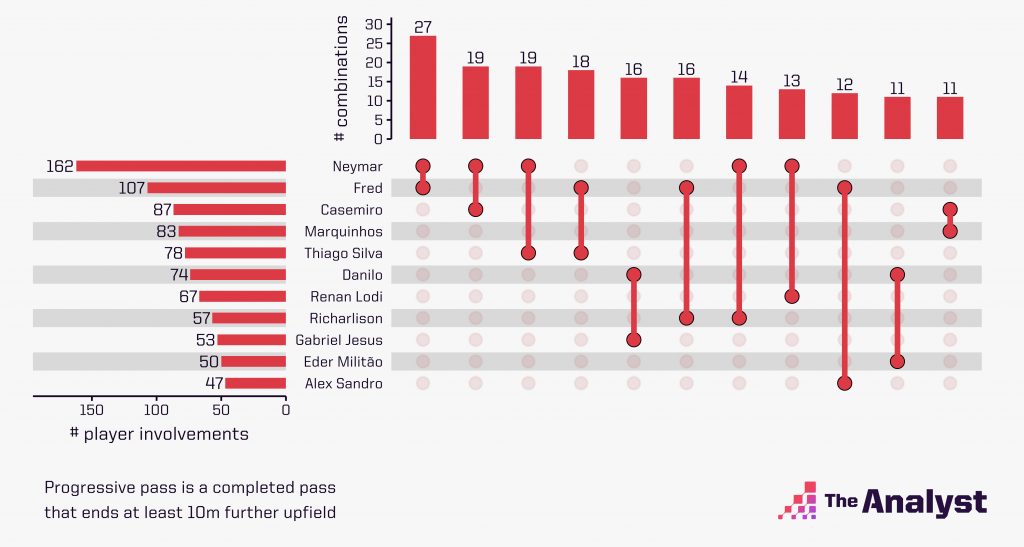
We can further break these combinations down by passer, receiver and pitch locations. Neymar is involved in the top three combos with Fred, Casemiro and Thiago Silva. He’s unsurprisingly almost always the one receiving the ball from these deeper players rather than them receiving from him:
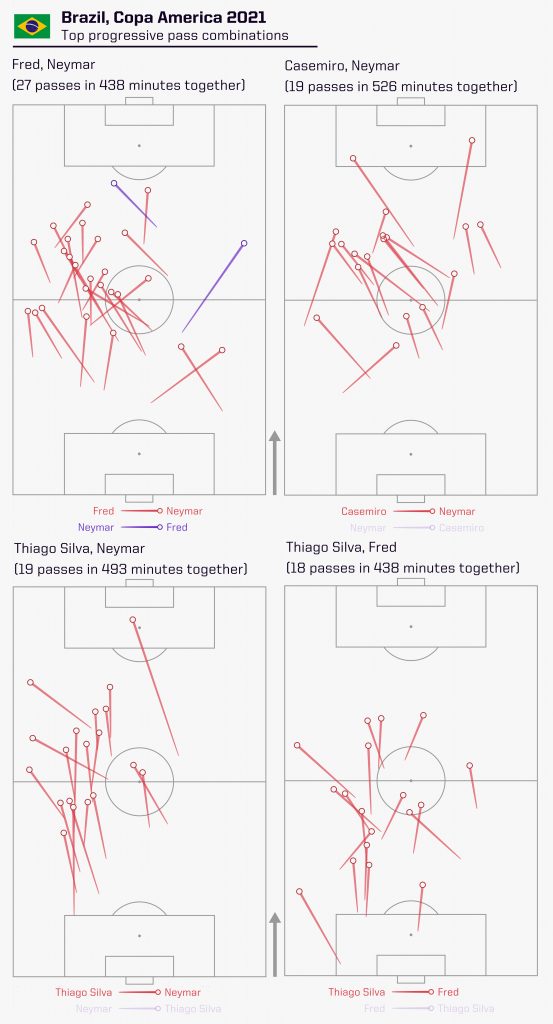
When he receives the ball, he’s hardly acting as a hold-up player. His 33 progressive carries (carries of 10+ metres) rank second…
…to…
…Messi’s 36.
That was predictable. But are Argentina less predictable than the Argentina you last saw, yet still reliant on Messi? It seems that’s the case. I don’t know the line at which reliant becomes overly reliant or if there is such a thing as overly reliant on one of the greatest players to ever play, but I (the numbers) can say this team is different, and for more reason than outlined above. They’re about more than deliberate build up with guys seemingly looking a pass or two ahead to find Messi, and how that’s playing out in the data has to do with – yes – Messi, but also players such as Rodrigo de Paul.
Messi has scored in this tournament. He’s scored twice from free kicks. Once from open play. One penalty. Four goals. Leads the tournament. 3.32 xG. Converted a penalty in the shootout with Colombia. You knew he could do all that.
Messi has assisted in this tournament, and in various ways – once from a high regain, once following a short corner, etc. Twice to Lautaro Martínez, once to de Paul, once to Alejandro Gómez and once to Guido Rodríguez. Five assists. Leads the tournament. 3.31 expected assists. Leads the tournament. You knew he could do that. But the difference in those assist and expected assist numbers indicates he’s getting the return he deserves on the chances he creates – and more.
Surpassing an xA total indicates your teammates are finishing the chances you create, but underperforming it indicates you are creating chances that are at least occasionally being wasted, and that was the case in the past. Combine his numbers from the 2018 World Cup, Copa América 2019 and six qualifiers for 2022, and in those 16 matches he’s underperformed his xG (four goals, 7.11 xG) and his teammates haven’t quite finished up to his xA (three assists, 3.5 xA).
Six matches this summer have been far more fruitful, so it’s probably worth understanding how Argentina are progressing the ball. What we see here is Messi is a massive part of it, but it’s not all on him. His 102 involvements among the top 11 player combinations accounts for 18.2%, a shade under Neymar’s rate.
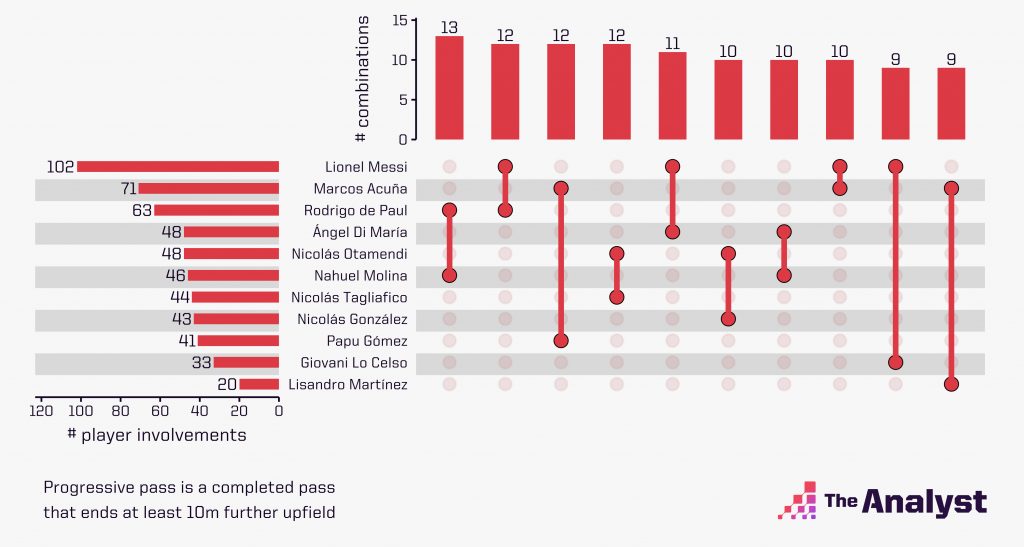
His involvements lead among their progressive passing combinations, but he’s only a part of one of the top four pairings. The Atlético Madrid-bound de Paul is a part of the top two, and he’s doing it in areas of the pitch Messi has been known to venture, whether Messi’s involved or not:
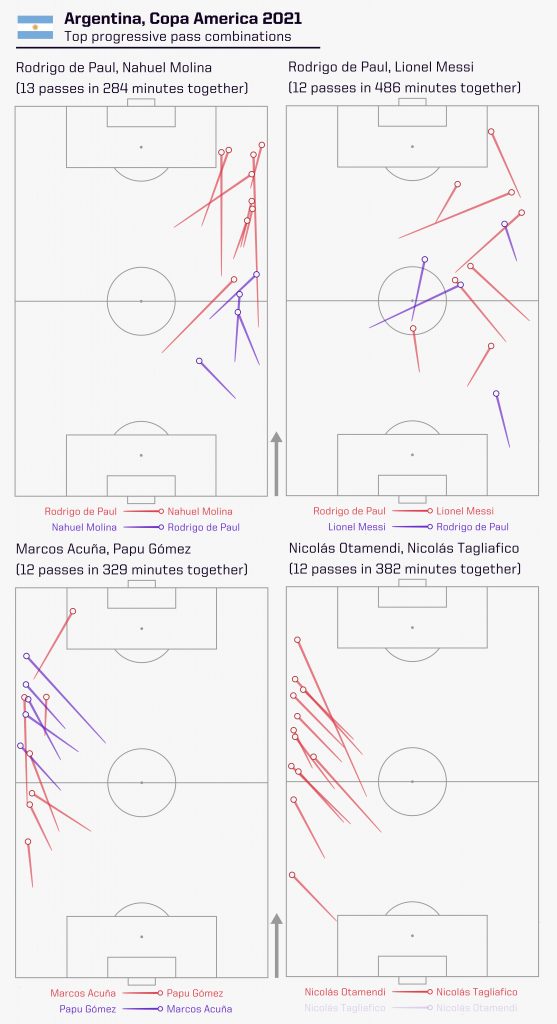
Now, it’s important to remember these are only progressive passes. There’s a lot more going on here with these players and others. And it’s certainly not to say de Paul is encroaching on or replacing the face of La Albiceleste. Rather, it’s one example of there being room for others, and Scaloni seems to be finding ways to get more out of Messi and his teammates.
Messi was in his prime when Argentina appeared in finals in three straight major tournaments between 2014 and 2016. After a 2019 Copa in which they came five points short of topping a group of Colombia, Paraguay and Qatar and were eliminated in the semis, there was real doubt about him playing in one again.
A man who traditionally has a stable club status and is criticised with his national team is now a free man without a club contract – a free man who may again have a functional national team. What hasn’t changed is none of that matters much if Argentina lose to a team that doesn’t lose.
Design by Briggs Clinard.
Enjoy this? Subscribe to our mailing list to get exclusive content.
